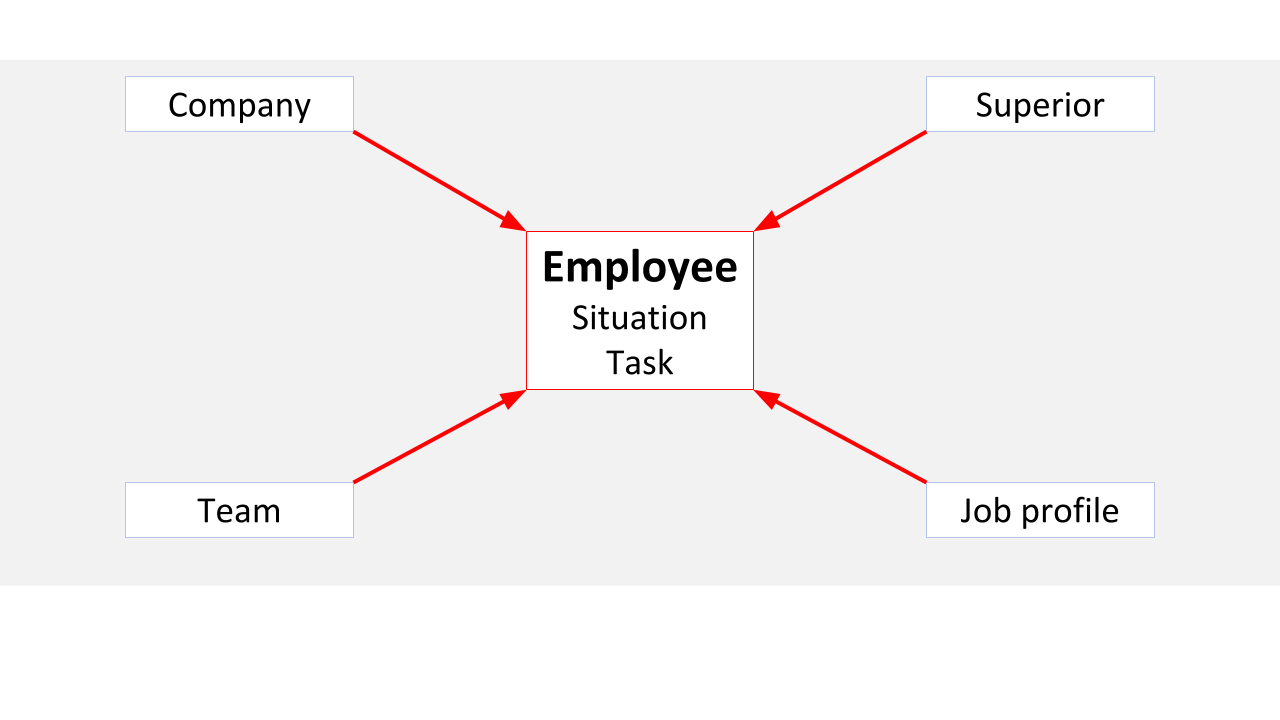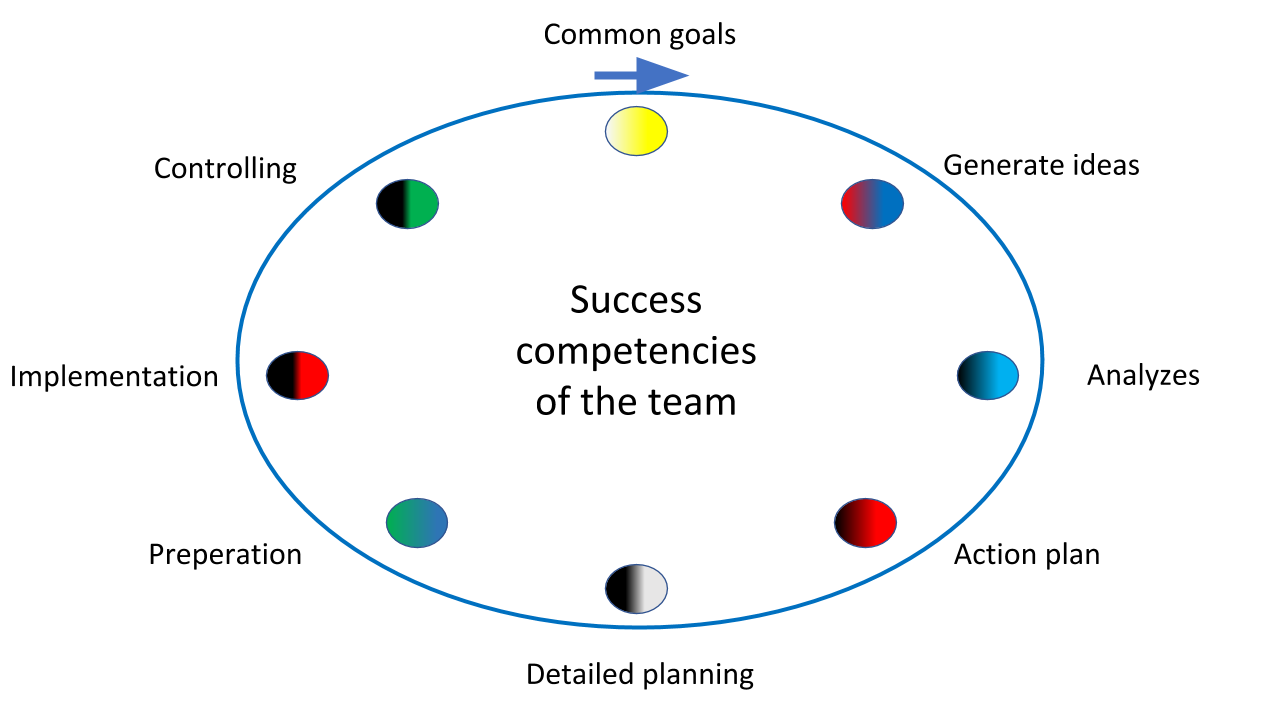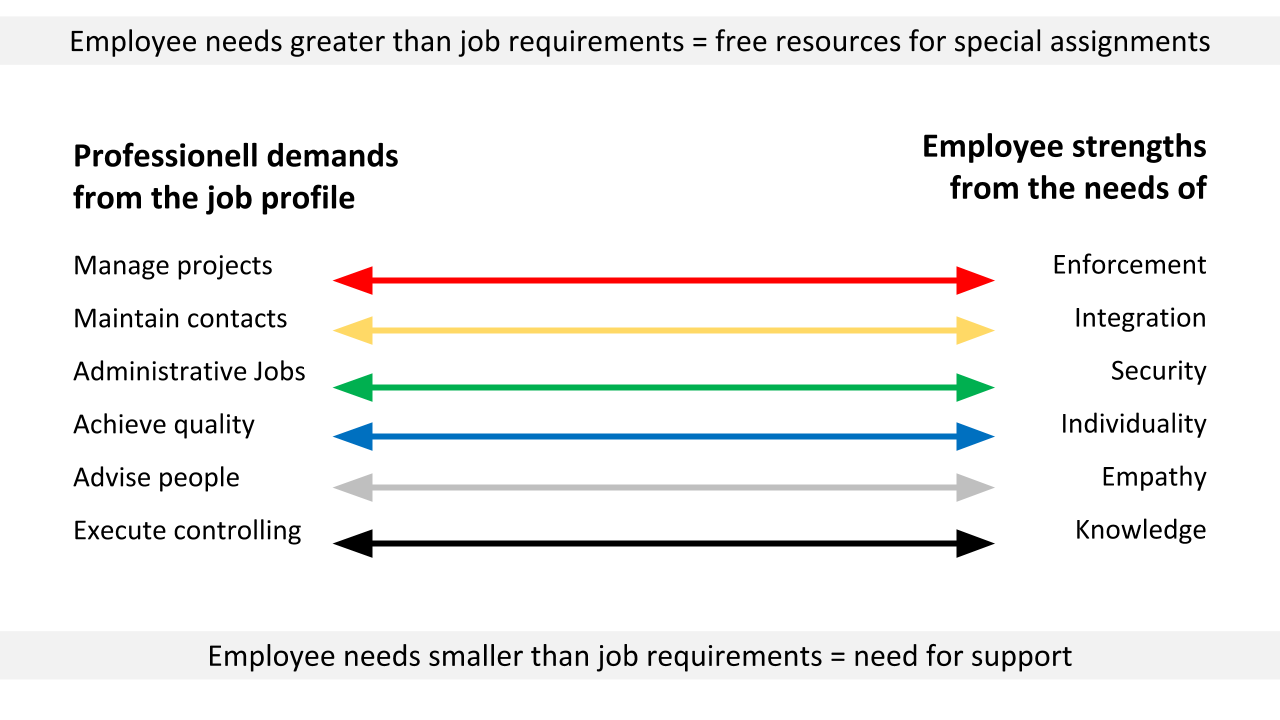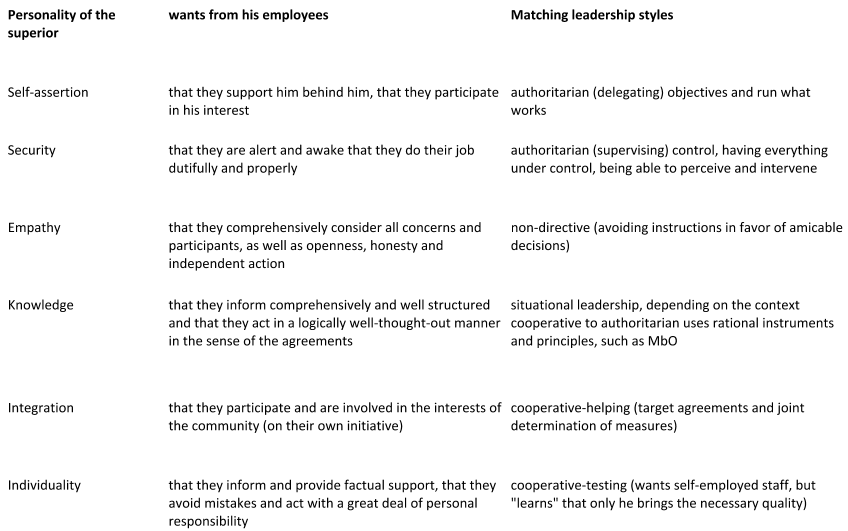Leadership
If you want to successfully lead an employee, a team or your company, then you are dealing with quite different people. Theoretically you need
- Goals that all participants find attractive
- A mutual understanding that knows the individual strengths and needs of the personalities
In every group that wants to achieve something together, we need as many different personalities as possible. Someone should want to make a difference, while someone else takes care of security. One person looks after the communicative adaptation and another looks after the deviating peculiarities. Diversity has great advantages.
Knowing the differences
For the art of leadership we use the knowledge of the differences. All the personalities involved have effects on the others - and they generate counter-effects.
Characteristics are the result of long practised behaviour. Behaviour serves certain needs. In order to survive as individuals or as species, we humans strive for assertiveness, belonging, security, individuality, empathy and insight. These basic needs have the greatest effects. Because of their existential character, they give rise to fears when their fulfilment is threatened, and powerful actions when satisfaction seems possible.
A person's "inner" system is determined by the simultaneity and contrariness of these needs. Depending on the personality, one or more of these aspects will be prioritized. One develops into an extroverted entertainer, a dynamic entrepreneur, a critical researcher and so on.
The effect of these different orientations always refers to the external and
internal situation.

If, for example, you strive for security, you will then react anxiously and warn to be cautious when danger threatens - an assertively-oriented employee would not even notice potential, e.g. economic threats - as long as he can only develop freely...
Depending on the context, for example the type of leadership, the current distribution of tasks, the assigned job profile, the dynamics in the team, the orientation of the company, etc., these two employees will influence the system in their quite different ways.
Those who want smooth processes and smoothly functioning teams should know the causes of friction and conflict and use them for synergies.
Enforcement types need goals
Ideally, goals and change projects are communicated in such a way that emotional resistance is largely excluded. Goal synchronization is necessary, for example, when the marketing manager presses for participation in a trade fair, while the head of finance wants to reduce all his budget. If you don't advertise, one of them will die. Many companies have already broken their hopes, the other one.
Of course both are right - and certainly there are more complex situations in which decisions have to be made and enforced. In principle, however, it amounts either to lukewarm compromises (taking a bit of action and doing a little harm to the company) or to unilateral decisions that deprive the other side of any desire for further commitment (one of the reasons for the internal dismissals).
IPM shows in the team profiles which decision priorities are set by which
employee.

The emotional distances between the participants are visualized and it already becomes clear that the colleagues are no crackpots or slowers, but can make strategically and economically meaningful contributions in the sense of the company. One has ideas and the other analyses the feasibility and consequences and so on.
Everyone makes his or her personal contribution in the decision-making cycle and is accepted with his or her special characteristics. This improves the mood, the willingness to get involved and enables personality-related synergies. Belonging and empathy (yellow-white), for example, complement each other very well when it comes to swearing the team to common goals, while implementation and awareness (red-black) jointly develop action concepts. Synergy can be experienced.
Integration types need relationships
Relationships are fascinating because people are different. But, from the otherness arise opportunities and risks, because not everyone "works" the way you expect. Avoiding the risks that arise from differing views and priorities works reasonably well where reporting and control systems ensure compliance with organizational boundaries. Allowing opportunities sounds simpler than it is in practice, because in order to do so, those involved need to know that they should think, feel and act independently!
Employee leadership is the answer to individualisation in everyday professional life. The better an employee is managed, the less expensive control and braking systems have to be used and the more can be trusted on one's own initiative. As a superior, you influence the emotional orientation of the employee to a great extent. His question is: What do I have to do to at least be tolerated by the boss?
The requirements from the job profile can pull the employee in a different direction: What needs to be done to meet the requirements? For his own satisfaction, the employee must also behave in such a way that he does not have to bend himself permanently.
IPM answers the question: "Who do I motivate and lead in which way? with the individual management instructions.

Each employee is described in terms of his or her personality, how he or she achieves positive motivation and what needs to be taken into account in general communication and agreements on work content. The relationship level between supervisor and employee is then examined. Where does the superior unconsciously demand too little - and where too much? What is to be done if in some areas of the personality it is to be expected that one talks past each other?
The requirements from the job profile are analysed in two directions: Is the employee overburdened by his or her personality? And: Is he possibly underchallenged? In both cases it makes sense to take countermeasures either through motivation and leadership or through organisational measures.
The goal is to have employees who are well integrated and enthusiastically committed to their tasks in the long term.
Security types need reliability
To deploy employees in such a way that they are permanently entrusted with tasks that they can and want to perform in a pleasant environment is a perfectly reasonable goal. Because it is not only human, but also economically sensible if organisation and personnel work work together in such a clever way that the combination of tasks to jobs - and the assignment of employees to jobs - takes place precisely.
Personnel deployment becomes a risk if you are unsure whether the employee will be able to cope with the tasks ahead. You will have a good feeling when filling a position if you know that the tasks are performed by a person who is predestined for the job due to his personality and experience.
It's actually so simple: you have to look at both and compare them: job profile and employee profile.
In the past, jobs were created for purely factual reasons - which meant that a salesperson also had to perform accounting tasks - or an accountant had to communicate with customers at the same time. There are clear risks when you have to do something you don't like. Forgetting, lack of quality and negative stress are consequences that neither the company nor the prayers can be affected by.

Of course, in practice you don't always have ideal situations. But you can achieve a lot with a good organization: The first step towards a starting situation that is reliable for all sides is the task-related analysis of the jobs - the second step is the value-neutral, appreciative examination of the basic needs of potential job holders. This provides the basis for further personnel or organisational decisions.
In order to ensure positive integration into the team and the benevolent support of superiors after filling the position, team profiles and management notes provide understandable and implementable suggestions.
Each job profile is a collection of different tasks. Some demand, many underchallenge or overchallenge the job holders. If one is not aware of this, one wears out the employee's strengths or wastes latent resources. You don't always find the exact mix of tasks that fits the competencies of the individual - but every attempt to approach the optimum opens up potential. For this you have to be informed.
Individualists want to be recognized
We should be informed about the competencies each employee brings with him or her on the basis of his or her individual personality. Then we have to think about the benefits for the team or the company resulting from these special features.

In this respect, many mistakes are made that are relevant to business management. Example: An excellent salesperson - hard-selling, door to door - is promoted to sales manager. After all, he earned it. The result: the number of good salespeople is reduced - the number of incompetent bosses rises. In the end, neither the former top man nor his new team, nor the company is served at all.
The essential competencies and strengths result from the personality. All people have the same basic needs that are essential for survival - but with different weightings. This results in different behaviors from childhood on, which have the sense to first ensure the fulfillment of the prioritized needs. A person who, for example, attaches the greatest importance to his or her sense of belonging and being a part of it, learns to make visions of himself or herself and thus to be involved in relationships. He experiences again and again that he is internally satisfied if he succeeds in convincing others of his intentions and taking them with him on his adventures. If you know this, you don't need to make any significant effort to motivate him.
Position yourself clearly
If we want our employees to contribute their individual skills, then it makes sense for their superiors to position themselves just as clearly.
